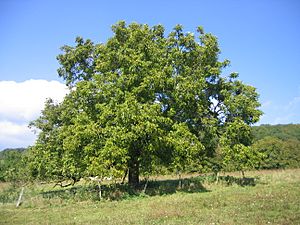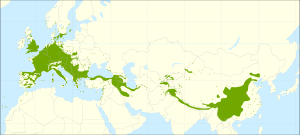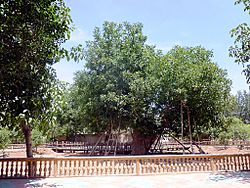Persian walnut facts for kids
Quick facts for kids Persian walnut |
|
|---|---|
 |
|
| Mature walnut tree | |
| Conservation status | |
| Scientific classification | |
| Genus: |
Juglans
|
| Species: |
regia
|
 |
|
| Distribution map | |
| Synonyms | |
|
Juglans duclouxiana Dode |
|
Juglans regia, also known as the Persian walnut or English walnut, is a type of walnut tree. It comes from a large area stretching from the Balkans in Europe all the way to the Himalayas and southwest China. People grow this tree all over Europe because it produces tasty walnuts.
The walnuts we eat around the world come from this tree. China is the biggest producer of walnuts for sale.
Contents
About the Walnut Tree
Juglans regia is a big tree that loses its leaves in autumn. It can grow to be 25–35 meters (80 to 120 feet) tall. Its trunk can be as wide as 2 meters (6 feet). These trees usually have a short trunk and a wide, spreading top. However, in thick forests, they grow taller and narrower. They need lots of sunlight to grow well.
The bark of young trees is smooth and olive-brown. On older branches, it turns silvery-grey and has rough cracks. Like all walnut trees, the inside of the twigs has air spaces. This makes the pith (the soft center) look brownish and chambered.
The leaves grow one after another along the branch. They are 25–40 cm (10 to 16 inches) long. Each leaf has 5 to 9 smaller leaflets, with one leaflet at the very end. The three leaflets at the top are the biggest, about 10–18 cm (4 to 7 inches) long. The leaflets at the bottom are much smaller.
The male flowers hang down in groups called catkins, which are 5–10 cm (2 to 4 inches) long. The female flowers grow in small groups of two to five at the ends of branches. In autumn, these flowers turn into a fruit. This fruit has a green, soft outer layer and a brown, bumpy nut inside. The whole fruit falls off the tree in autumn. The seed inside the nut is large, has a thin shell, and tastes rich and delicious.
Where the Name "Walnut" Comes From
The old Latin name for the walnut was nux Gallica, which means "Gallic nut." This might refer to the region of Galatia in Turkey, which is in the western part of where these trees naturally grow.
The word "walnut" in English and other Germanic languages comes from an old word meaning "foreign nut." It was called this to tell it apart from nuts that grew naturally in those areas, like the hazelnut.
In some places, the tree has different names. In North America, it's often called the "English walnut." This might be because English sailors helped spread the nuts a long time ago. Or, it was called this to tell it apart from walnuts native to America.
In China, the edible walnut is called hú táo, which means "Hu peach." This suggests that ancient Chinese people thought the tree came from the "Hu" barbarians to the north and northwest of China. In Mexico, it's called nogal de Castilla, meaning "Castile walnut." This suggests it was brought by Spaniards from Castile.
Where Walnuts Grow
Original Home
One of the places where Juglans regia first grew is Iran. But because walnuts have been grown for so long and are found in so many places, it's hard to know exactly where they originally came from. Scientists have found old walnut pollen and nuts in different places. These findings suggest that walnut trees might have survived the last ice age in several safe spots, including southern Europe, the Near East, China, and the Himalayas.
Today, some of the largest natural walnut forests are in Kyrgyzstan. Here, trees grow in huge forests at heights of 1,000–2,000 meters (3,300–6,600 feet), especially in a place called Arslanbob.
How Walnuts Spread Around the World
Around 300 BC, Alexander the Great brought this "Persian nut" from Iran and Central Asia to Macedonia and Greece. These trees produced fruit along their branches. They mixed with other types of walnut trees that produced fruit only at the ends of branches. This created new trees that produced larger fruits along their branches. The Romans then helped spread these trees across southern Europe and northern Africa.
Later, in the Middle Ages, traders traveling along the Silk Road brought these types of walnuts to southern Turkey. It is believed that J. regia seeds came to China from Central Asia about 2000 years ago. In some areas, they now grow wild.
Cultivated J. regia trees were brought to western and northern Europe very early, possibly during Roman times or even before. English colonists brought them to the Americas in the 1600s.
Today, important places for growing walnuts include California in the United States, France, Serbia, Greece, Bulgaria, Romania, and Hungary in Europe, China in Asia, Baja California and Coahuila in Mexico, and Chile in Latin America. Recently, people have started growing them in New Zealand and southeast Australia too. Walnuts are grown widely between 30° and 50° latitude in the Northern Hemisphere and 30° and 40° in the Southern Hemisphere. Their high-quality nuts are eaten fresh or pressed to make flavorful oil. Many different types of walnuts have been grown to produce larger nuts with thinner shells.
Life Cycle of a Walnut Tree
Here you can see the different stages of a walnut tree's life.
Walnut Nutrition
| Nutritional value per 100 g (3.5 oz) | |
|---|---|
| Energy | 654 kcal (2,740 kJ) |
|
13.7 g
|
|
| Sugars | 2.6 |
| Dietary fiber | 6.7 g |
|
65.2 g
|
|
| Saturated | 6.1 g |
| Monounsaturated | 8.9 g |
| Polyunsaturated
omega‑6
|
47.2 g
9.1 g
38.1 g
|
|
Protein
|
15.2 g
|
| Vitamins | Quantity
%DV†
|
| Thiamine (B1) |
30%
0.34 mg |
| Riboflavin (B2) |
13%
0.15 mg |
| Niacin (B3) |
7%
1.13 mg |
| Pantothenic acid (B5) |
11%
0.57 mg |
| Vitamin B6 |
42%
0.54 mg |
| Folate (B9) |
25%
98 μg |
| Choline |
8%
39.2 mg |
| Vitamin C |
1%
1 mg |
| Vitamin E |
5%
0.7 mg |
| Vitamin K |
3%
2.7 μg |
| Minerals | Quantity
%DV†
|
| Calcium |
10%
98 mg |
| Copper |
80%
1.6 mg |
| Iron |
22%
2.9 mg |
| Magnesium |
45%
158 mg |
| Manganese |
162%
3.4 mg |
| Phosphorus |
49%
346 mg |
| Potassium |
15%
441 mg |
| Selenium |
7%
4.9 μg |
| Sodium |
0%
2 mg |
| Zinc |
33%
3.1 mg |
| Other constituents | Quantity |
| Water | 4.1 g |
|
Link to USDA Database entry
|
|
| †Percentages estimated using US recommendations for adults. | |
English walnuts are very nutritious! For every 100 grams, they contain about 654 calories. They are made up of 4% water, 65% fat, 15% protein, and 14% carbohydrates.
Walnuts are packed with important dietary minerals. They have a lot of manganese, phosphorus, magnesium, zinc, and iron. They also provide many B vitamins, like B6, thiamine, and folate. Plus, they are a good source of dietary fiber.
The fats in walnuts are mostly healthy fats. These include oleic acid, linoleic acid, and linolenic acid.
Walnut Allergies
Some people can have a serious allergic reaction to walnuts and other tree nuts. These reactions can be life-threatening.
Walnuts in Culture
In Skopelos, a Greek island, there's an old story. It says that if you plant a walnut tree, you will die as soon as the tree grows tall enough to "see" the sea. This saying, and similar ones in other places, refers to how slowly walnut trees grow and how long it takes for them to produce fruit.
In Benevento, Italy, there's a very old tradition about witches. People believed that witches from all over Italy would meet for their secret gatherings under a special walnut tree in Benevento. This legend has inspired many stories and works of art, like a ballet and a violin piece. The Italian liqueur called Strega even has a picture of this famous walnut tree with witches dancing under it on its label.
Growing Walnuts
Walnut trees grow best in rich, deep soil. They need lots of sunshine and long, warm summers. The central valley in California is a great place for them.
Other plants often don't grow well under walnut trees. This is because the fallen leaves and husks contain a chemical called juglone. This chemical acts like a natural weed killer. Also, horses that eat walnut leaves can get a hoof problem called laminitis.
Mature walnut trees can grow to be 50 feet tall and wide. They can live for more than 200 years and develop huge trunks that are over 8 feet thick.
Types of Walnuts (Cultivars)
There are many different types of Juglans regia walnuts, called cultivars. Each type has slightly different features, like nut size or shell thickness. For example, the 'Buccaneer' walnut tree produces many nuts. It also makes pollen for a long time, which helps other walnut trees grow nuts. This tree grows to a similar size as other walnuts and its leaves appear late, helping it avoid damage from late frosts.
Here are some common types:
- Purpurea
- Broadview
- Cascade
- Allegheny
- Bedco 1
- Coble #2
- Hansen
- Kaiser
- KY Giant
- Lake
- McKinster
- Somers
- Utah Giant
- Colby
- Greenhaven
- Reda
- Shiawassee
- Perry
- S-1
- Looking Glass
- China-B
- Champion
- Northern Prize
- Placentia
Walnut Pests
Walnut trees can be bothered by the Rhagoletis juglandis, also known as the walnut husk fly. This fly lays its eggs in the green outer husks of the walnut fruit. Some types of walnuts are more likely to be infested than others. This is because their husks might be softer or thinner. For example, 'Eureka', 'Klondike', 'Payne', 'Franquette', and 'Ehrhardt' walnuts are often more affected by these flies.
| Walnut production (shelled) – 2019 | |
|---|---|
| Country | (millions of tonnes) |
|
|
|
|
|
|
|
|
|
|
|
|
|
|
|
|
|
|
|
|
|
Walnut Production
In 2019, the world produced about 4.5 million tonnes of shelled walnuts. China was the biggest producer, growing 56% of all walnuts. The United States and Iran were also major producers.
Other Uses for Walnuts
The Navajo people used the hulls (outer coverings) of walnuts to make a brown dye.
Walnut Wood
The inner wood of the walnut tree, called heartwood, is a heavy, hard, and strong wood. When it's first cut, it can be a mustard color, but it darkens to a rich chocolate-brown or black over a few days. The outer wood, called sapwood, is cream to tan.
Walnut wood is highly valued by people who make fine wooden items. It's known for being strong, shiny, and having a beautiful shimmer. It's used for high-quality flooring, guitars, furniture, thin sheets of wood called veneers, knobs, handles, and even parts of gunstocks.
Images for kids
See also
 In Spanish: Nogal común para niños
In Spanish: Nogal común para niños




















